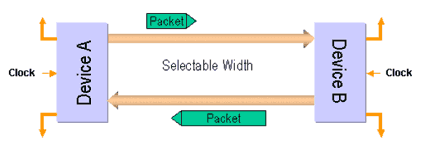Future Promise for Graphics: PCI Express
PCI Express
The new bus that is set to replace both PCI and AGP in the mid-term is called PCI Express, often abbreviated to PCIe or PCIx. However, despite the similar name, it has nothing to do with the PCI-X bus found on many workstation and server class boards. To prevent any confusion, we will therefore refrain from using any abbreviations and stick with the full name, PCI Express.
A PCI Express lane allows to transfer data in both directions simultaneously.
The underlying design of the PCI Express architecture differs completely from that of the "classical" PCI bus. For one thing, PCI Express uses a serial data transfer scheme, which allows for higher clockspeeds. This, coupled with the fact that several PCI Express channels (or "lanes") can be bundled for each expansion slot leaves room for stages of expansion, such as x8 and x12. Lastly, the same data rate is available in both directions simultaneously.
As it looks now, the standard expansion slot on future motherboards will be the PCI Express x1 slot. In this case, "x1" means the slot has one PCI Express lane, which will give it a bandwidth of 250 MB/s (500 MB/s if you count the bandwidth in both directions, i.e. full-duplex), making it almost twice as fast as PCI. On top of that, devices will nor longer find themselves competing for bandwidth, as each slot will have the full 250 MB/s for itself.
The architecture of PCI Express data transfers.
Graphics cards will use the x16 PCI Express slot. Yes, that means 16 lanes, which add up to a total peak bandwidth of 4 GB/s, or 8 GB/s counting the 4 GB/s in the other direction. Still, these full-duplex numbers should really be viewed more as marketing figures and less as relevant to the end user, as currently only the transfer rate in one direction is of any importance for graphics performance in any way.
So far, that gives us a twofold increase in memory bandwidth over AGP 8x for graphics cards. Sounds good? It is, although it will take quite some time until this will really show in any applications, especially games. If you'll recall, the "jump" from AGP 4x to AGP 8x yielded hardly any performance increases, as the following tests show.
Get Tom's Hardware's best news and in-depth reviews, straight to your inbox.

